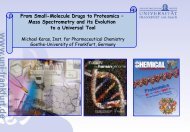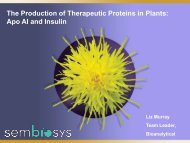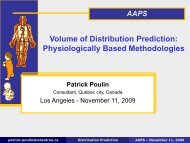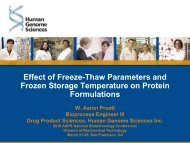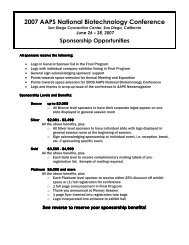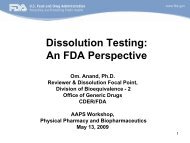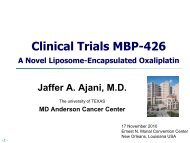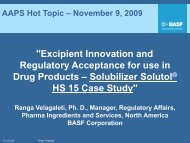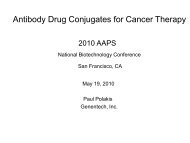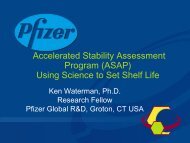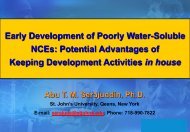Mechanisms of Protein Degradation
Mechanisms of Protein Degradation
Mechanisms of Protein Degradation
- No tags were found...
You also want an ePaper? Increase the reach of your titles
YUMPU automatically turns print PDFs into web optimized ePapers that Google loves.
Biotherapeutics Pharm Sci: PhRD<strong>Mechanisms</strong> <strong>of</strong> <strong>Protein</strong> <strong>Degradation</strong>Kevin King14 November 2010
Biotherapeutics Pharm Sci: PhRDContent• Overview <strong>of</strong> protein structure• Chemical degradation• Physical degradation2
Biotherapeutics Pharm Sci: PhRDContent• Overview <strong>of</strong> protein structure• Chemical degradation• Physical degradation3
Biotherapeutics Pharm Sci: PhRDBiotherapeutics…..the Nature <strong>of</strong> the Beast
Biotherapeutics Pharm Sci: PhRDQMVESSCVASGQMVESSCVASGQMVESSCVASGQMVESSCVASGQMVESSQMVESSCVASGQMVESSCVASGQMVESSCVASGQMVESSCVASGQMVESSQMVESSCVASGQMVESSCVASGQMVESSCVASGQMVESSCVASGQMVESSComplexQMVESSCVASGQMVESSCVASGQMVESSCVASGQMVESSCVASGQMVESSQMVESSCVASGQMVESSCVASGQMVESSCVASGQMVESSCVASGQMVESSQMVESSCVASGQMVESSCVASGQMVESSCVASGQMVESSCVASGQMVESSQMVESSCVASGQMVESSCVASGQMVESSCVASGQMVESSCVASGQMVESSQMVESSCVASGQMVESSCVASGQMVESSCVASGQMVESSCVASGQMVESSQMVESSCVASGQMVESSCVASGQMVESSCVASGQMVESSCVASGQMVESSBiotherapeuticQMVESSCVASGQMVESSCVASGQMVESSCVASGQMVESSCVASGQMVESSQMVESSCVASGQMVESSCVASGQMVESSCVASGQMVESSCVASGQMVESSQMVESSCVASGQMVESSCVASGQMVESSCVASGQMVESSCVASGQMVESSQMVESSCVASGQMVESSCVASGQMVESSCVASGQMVESSCVASGQMVESSQMVESSCVASGQMVESSCVASGQMVESSCVASGQMVESSCVASGQMVESSQMVESSCVASGQMVESSCVASGQMVESSCVASGQMVESSCVASGQMVESSQMVESSCVASGQMVESSCVASGQMVESSCVASGQMVESSCVASGQMVESS1000+ amino acidsQMVESSCVASGQMVESSCVASGQMVESSCVASGQMVESSCVASGQMVESSQMVESSCVASGQMVESSCVASGQMVESSCVASGQMVESSCVASGQMVESSQMVESSCVASGQMVESSCVASGQMVESSCVASGQMVESSCVASGQMVESSQMVESSCVASGQMVESSCVASGQMVESSCVASGQMVESSCVASGQMVESSQMVESSCVASGQMVESSCVASGQMVESSCVASGQMVESSCVASGQMVESSQMVESSCVASGQMVESSCVASGQMVESSCVASGQMVESSCVASGQMVESSQMVESSCVASGQMVESSCVASGQMVESSCVASGQMVESSCVASGQMVESSQMVESSCVASGQMVESSCVASGQMVESSCVASGQMVESSCVASGSSSSSS
Biotherapeutics Pharm Sci: PhRD<strong>Protein</strong> StructurePrimary Secondary Tertiary Quaternary-helixmonomerdimertrimertetramer…amino acidsequenceb-sheets=> Correct primary and higher order structures required for function
Biotherapeutics Pharm Sci: PhRDImportance <strong>of</strong> Understanding <strong>Degradation</strong> Pr<strong>of</strong>ilesSmall moleculesBiotherapeuticsFormulate This…bioavailability…shelf life!
Biotherapeutics Pharm Sci: PhRDPotential Routes <strong>of</strong> <strong>Degradation</strong>Deamidation (Asn, Gln)Oxidation (Met, Trp, Cys)V LV HCDR1CDR2CDR3CDR3CDR2CDR1V HV LDR1CDR2CDR3C 1 HSC 1 HCDR2CDR3Glycation(Lys)CLS H SS HSSC 2HC 2HSSCLIsomerization (Asp)C 3HC 3HPeptide bondhydrolysis/truncations(Asp-Pro, Asp-Xxx)Pyroglutamate Formation(N-terminal Gln, N-terminal Glu)Denaturation, Aggregation,precipitation
Biotherapeutics Pharm Sci: PhRDWhat Factors Affect Chemical<strong>Degradation</strong>?• pH• Buffer species• Other excipients• Light• Oxygen• Metal ions• TemperatureHydrolysis, deamidationDeamidationMaillard reactionPhoto decompositionOxidationHydrolysis, oxidationMost routes
Biotherapeutics Pharm Sci: PhRDContent• Overview <strong>of</strong> protein structure• Chemical degradation• Physical degradation11
Biotherapeutics Pharm Sci: PhRDDeamidationDeamidation <strong>of</strong> two key asparagines (shown in red)in Bcl-xL prevents this protein from carryingout its normal function, to block cell suicideYarnell, C&EN, 81, 47, Feb17, 2003
Biotherapeutics Pharm Sci: PhRDDeamidation <strong>of</strong> <strong>Protein</strong>s• Non-Enzymatic reaction which occurs at Asn and Gln• Hydrolysis reaction requiring water• Pathways depend on pH• Cyclic imide pathway under slightly acidic to basicconditions• Direct hydrolysis under acidic conditions• Minimum rate in pH range ~ 3 – 4• Buffer catalytic effect in pH range ~ 7 - 12• Rate is 5-10x faster for Asn than for Gln• Generates both normal and beta peptide bonds• Rate is affected by the N+1 residue•Interconvertibility isoAsp-Y to Asp-Y
BiotherapeuticsDeamidationPharm Sci: PhRD<strong>of</strong> AsparagineAsnz = 0-carbonylOO. . .NHNHNH. . .OOHOONHOOONH 2NORNH3- 17 Da -carbonyl. . .ROOH 2 O+18 DaNH. . .. . .NHNHNH. . . . . .NHNH O NH. . .O ROH ROpH range (~ 5 – 12)Succinimide(cyclic imide)OOProducts ratioIso-Asp : AspBasic ~2 – 3 : 1Asp, +1 Da, z = -1by hydolysis at -carbonyliso-Asp, +1 Da, z = -1by hydrolysis at -carbonylAdapted from JCarroll
Biotherapeutics Pharm Sci: PhRDDeamidation <strong>of</strong> AsparaginepH range (~ 1 - 2)Not observedAcidicDirect HydrolysispathwayPatel and Borchardt, PharmRes, 7, 703, 1990
Biotherapeutics Pharm Sci: PhRDDeamidation <strong>of</strong> <strong>Protein</strong>s (Asn)Effect <strong>of</strong> the (n+1) th ResidueFirst-order deamidation half times <strong>of</strong> pentapeptidesGlyXxxAsnYyyGly in days at pH 7.4, 37.0°C, 0.15 M Tris·HCl• Degree <strong>of</strong> side-chain branchingcritical in (n+1) th residue• Charge <strong>of</strong> residue not critical(exceptions: His, Ser, Thr)• Little effect <strong>of</strong> (n-1) th residueFrom analogous Gln pentapeptides:• Gln-Gly half-time~ 400- 600 days• Other Gln- sequences even longerRobinson and Robinson, PNAS, 98, 944, 2001
Biotherapeutics Pharm Sci: PhRDDeamidation <strong>of</strong> <strong>Protein</strong>sImpact <strong>of</strong> pH / Buffer / Ionic Strength• Ionic Strength: Little to no effect• pH: Increased rate w pH• Buffer: Catalysis by Phosphate, CarbonateBrennan and Clarke, Ch 5. in Deamidation and Isoaspartate Formation in <strong>Protein</strong>s andPeptides, DWAswad Ed. CRC Press, 1995
Biotherapeutics Pharm Sci: PhRDDeamidation <strong>of</strong> <strong>Protein</strong>sImpact <strong>of</strong> Structure• Asn is a “weak helix breaker”, somewhatinfrequent in -helices• 2 0 structures (-turns, -helices) tend tostabilize Asn residues against deamidation– Effect weak in -helices; may even destabilize– Stabilization probably due to conformational restrictions(critical distance <strong>of</strong> approach)– Stabilization also probably due to reduced nucleophilicactivity <strong>of</strong> the backbone NH centers, which are H-bonded in -helices and in all positions except one <strong>of</strong> the-turns– Expect stabilization in -sheets alsoXie and Schowen, JPS, 88, 8, 1999
Biotherapeutics Pharm Sci: PhRDDeamidation <strong>of</strong> <strong>Protein</strong>sImpact <strong>of</strong> Structure• Probability <strong>of</strong> deamidation increases when alabile sequence falls in a flexible domain <strong>of</strong> theprotein.• Computational method for prediction <strong>of</strong> rate <strong>of</strong>deamidation <strong>of</strong> Asn residues gives mostaccurate results when both primary sequenceand 3D structure data is used (96.5% vs 79.8%with primary sequence alone and vs 64.3% with3D structure alone) (Robinson, PNAS, 99, 5283, 2002)(www.deamidation.org)
Biotherapeutics Pharm Sci: PhRDDeamidation <strong>of</strong> <strong>Protein</strong>sImpact on Activity• Asn30 to Asp on LC: Potency ~70%. Asp102 to isoAsp on HC: Potency < 30%(Harris et al, JChromB, 752, 233, 2001)• Homodimers <strong>of</strong> SCF with IsoAsp in place <strong>of</strong> Asn10 was 50X less potent, while Asphomodimers had 150% <strong>of</strong> normal activity (Hsu et al., Biochemistry, 37, 2251, 1998)• Calbindin D 28K : Asn203 to Asp conversion has no impact on Ca 2+ binding affinity and(the high) cooperativity. Asn203 to isoAsp reduces affinity at multiple sites leading toreduced affinity and sequential binding (Vanbelle et al., ProtSci., 14, 968, 2005)• Deamidation <strong>of</strong> N146 and not N78 had a significant impact on chaperone activity andstructural properties <strong>of</strong> B-crystallins (Gupta and Srivastava, IOVS, 45, 206, 2005)• Presence <strong>of</strong> < 5% deamidated Amylin20-29 leads to aggregation and amyloidformation (Nilsson, ProtSci, 11, 342, 2002)• Enhanced bioactivity <strong>of</strong> mammalian somatotropin through selective deamidation(Asn to isoAsp in region 96-101 <strong>of</strong> bSt) (WO 1987/01708)• Activity <strong>of</strong> a protein may or may not be impacted by deamidationdependent upon– Position <strong>of</strong> deamidation and impact on structure/conformation– Extent <strong>of</strong> deamidation in pool
Biotherapeutics Pharm Sci: PhRDDeamidation <strong>of</strong> <strong>Protein</strong>sBiological Relevance• Intestinal T-cell response to -gliadin in adult celiac diseaseis focused on a single (enzymatically) deamidated Gln(targeted by tissue transglutaminase) (JEM, 191, 603, 2000)• Deamidation <strong>of</strong> N146 in B-crystallins has been implicatedin the formation <strong>of</strong> cataracts (IOVS, 45, 206, 2004).• Two <strong>of</strong> (9) Asn in Bcl-x L undergo selective deamidation thatblocks its pro-survival function (blocking pro-apoptopicproteins) allowing cell death (Cell, 111, 51, 2002; PLoS Biology, 5, 0039, 2007).• In vivo deamidation half-life <strong>of</strong> Asn55 in an IGg1 (located inCDR2 <strong>of</strong> HC) is around 140 hrs irrespective <strong>of</strong> route <strong>of</strong>administration (IV or SC) (AnalChem, 77, 1432, 2005)• Ageing / Molecular clocks (Asn half-lives <strong>of</strong> 1 d to 50 yrs)
Biotherapeutics Pharm Sci: PhRDDeamidation and ApoptosisRobinson et al., PNAS, 66, 753, 1970
Biotherapeutics Pharm Sci: PhRDIsomerizationRacemization
Biotherapeutics Pharm Sci: PhRDIsomerization in <strong>Protein</strong>s• Asn, Asp and Gln• Succinimide intermediate• Asp much slower than Asn via thismechanism• Primary route is the deamidation whichyields iso-Asp and Asp in a roughly 3:1ratio.• Rate and propensity determined bylocation and mobility.
Biotherapeutics Pharm Sci: PhRDIsomerization and Racemization in <strong>Protein</strong>sRates:N isoDD isoDDaniel et al., BiochemJ., 317, 1, 1996
Biotherapeutics Pharm Sci: PhRDDeamidation, Isomerization andRacemization (Asx)Yoshioka and Stella, Ch. 5, 2000
Biotherapeutics Pharm Sci: PhRDHydrolysis <strong>of</strong> Peptide Bonds• -x-Asp-y sequence is considered labile• Hydrolysis in dilute acid at least 100X faster than otherpeptide bonds• <strong>Mechanisms</strong> similar to deamidation succinimideformation, followed by racemization and isomerization• Asp-Pro (Pro-Asp?) susceptible (8-20X faster compared toother Asp-x or x-Asp) under acidic conditions• Asp-Gly susceptible under highly acidic conditions (pH 0.3 –3)• -x-Ser-, -x-Thr-: Cleavage at N-terminal side faster than otherpeptide bondsMarcus, IntJPeptProtRes., 25, 542, 1985; Han et al., IntJBiochem, 15, 875, 1983;Oliyai and Borchardt, PharmRes., 10, 95, 1993
Biotherapeutics Pharm Sci: PhRDHydrolysis <strong>of</strong> Peptide BondsDaniel et al., BiochemJ., 317, 1, 1996Geiger and Clarke, JBC, 262, 785, 1987
Biotherapeutics Pharm Sci: PhRDDisulfideBreakage and Scramblinghttp://www.ehscenter.org/dbd/
Biotherapeutics Pharm Sci: PhRDDisulfides: Cleavage and ScramblingcysteinesCleavage: Reducing conditions e.g. in cytosolcystineThiol-disulfide exchange(neutral or alkaline environments; pH > ~8;protonated thiols are not reactive, pKa ~ 8.3)Disulfide reshuffling faster than formation/reduction <strong>of</strong> disulfides
Biotherapeutics Pharm Sci: PhRDGlycation• Reducing sugars reacting through classic Maillard reaction toamino groups• ε-amino group <strong>of</strong> Lys, N-terminal -amino susceptible• Implicated in complications <strong>of</strong> diabetes and ageing (stiffening<strong>of</strong> arteries, vascular narrowing, cataract formation –• AGE: Advanced Glycation Endproducts• Accumulates in slow-turnover proteins (eg collagen, -crystallins)• Impacts structure and function• Acidification [loss <strong>of</strong> positive charge(s)]• Insolubility• Cross-linking• Resistance to heat denaturation• Generation <strong>of</strong> chromophores (brown, yellow)• Impacted by pH, pka <strong>of</strong> aminoacid group, adjacent AA,Temperature, Concentration <strong>of</strong> reducing sugar, Conc<strong>Protein</strong>
Biotherapeutics Pharm Sci: PhRDGlycation (Maillard Reaction)glycatedglycated--Luthra and Balasubramanian, JBC, 268, 18119, 1993
Biotherapeutics Pharm Sci: PhRDDiketopiperazine
Biotherapeutics Pharm Sci: PhRDDiketopiperazine (DKP)• Often seen with dipeptide esters and amides• Nucleophilic attack <strong>of</strong> N-terminal nitrogen on theamide carbonyl between 2 nd and 3 rd residues• Peptides containing Gly as the 3 rd residue, or Pro in2 nd residue from N-terminal particularly susceptible• Favored in neutral or alkaline medium• DKP from x-Pro is impacted by cis-trans equilibrium<strong>of</strong> Pro, and dependent on charge distribution aroundpeptide bond. Cis facilitates ring closure.Powell, ACS567, Ch.7, 1994; Goolcharran and Borchardt, JPS, 87, 283, 1998
Biotherapeutics Pharm Sci: PhRDDiketopiperazine (DKP)Phe-Pro N-terminus in rhGHBattersby et al., IntJPepProtRes, 44, 215, 1994
Biotherapeutics Pharm Sci: PhRDPyroglutamic Acid (PyroE)Q PyroEE PyroE• N-terminal Gln can spontaneously cyclize to form PyroE• Gln-Gly reacts much fasterE PyroEN-terminal Glutamine (Q): Common, quantitativeCharge change (-1, loss <strong>of</strong> basic residue)Mass Change (-17 Da)N-terminal Glutamic Acid (E): Less commonCharge neutralMass Change (-18 Da)Adapted from JCarrol; Powell, ACS567, Ch.7, 1994; Chelius et al., AnalChem, 76, 2370, 2006
Biotherapeutics Pharm Sci: PhRDImpact on Charge Heterogeneity in<strong>Protein</strong>sChange on Stability• Deamidation (more acidic) (z = -1)• Succinimide (more basic or neutral)• Glycation (more acidic)• Pyroglutamate formation (more acidic) (z = -1)• Peptide Bond Hydrolysis (either acidic or basic)JCarroll
Biotherapeutics Pharm Sci: PhRDOxidation ProductsResiduesMetCysOxidation productsMet-Sulfoxide-S-S-disulfide crosslinks, sulfenicacid/sulfinic acid/solfonic acid2-oxoimidasoline, aspartate/asparagineN-formylkynurinine, kynurenineHisTrpTyr Try-Try crosslink, 3-4-dhydroxyphenylalanineBorchardt R. T. et al., Biotechnology and Bioengineering, Vol. 48, 490-500, 1995Shen F. J. et al., Techniques in <strong>Protein</strong> chemistry, Vol. III, 275-284
Biotherapeutics Pharm Sci: PhRD<strong>Protein</strong> Oxidation‣ Covalent modification <strong>of</strong> a protein‣ Induced by reactive oxygen intermediates or other oxidants‣ Can be caused by• Chemical reagents (H 2 O 2 , ·O 2 , metal ions, excipients)• UV light‣ Commonly modifies the residues• Met, Cys, Trp, His, Tyr‣ May cause reduced potency <strong>of</strong> protein, depending on site‣ May cause conformational change in protein, leading toaggregation
Biotherapeutics Pharm Sci: PhRDOxidation <strong>of</strong> <strong>Protein</strong>sAgents that can lead to <strong>Protein</strong> Oxidation• Chemical Reagents• (H 2 O 2 , Fe 2+ , Cu 1+ , Glutathione, HOCl, HOBr, 1 O 2 , ONOO - )• Activated phagocytes (oxidative burst activity)• -Irradiation in the presence <strong>of</strong> O 2• UV light, Ozone• Lipid peroxides (HNE, MDA, acrolein)• Mitochondria (electron transport chain leakage)• Oxidoreductase enzymes• (Xanthine oxidase, Myeloperoxidase, P-450 enzymes)• Drugs and their metabolitesShacter, Virtual Free Radical School http://www.healthcare.uiowa.edu/research/sfrbm/virtual.html
Biotherapeutics Pharm Sci: PhRDOxidation <strong>of</strong> <strong>Protein</strong>sTypes and <strong>Mechanisms</strong> Site-Specific Oxidation• Catalyzed by transition metals e.g., Fe(II) or Cu(I)• Involves generation <strong>of</strong> ROS and oxidation at metal binding site• His, Pro, Arg, Lys, Thr, Tyr, Met, Cys most susceptible Non-Site Specific Oxidation• Caused by (contaminant) oxidants such as H 2 O 2 , HOCl, oroxidizing radiation (e.g., light)• All susceptible residues Primary Formulation development relevant residues• Met, Cys, His, Trp, TyrShacter, DrugMetabRev, 32, 307, 2000; Stadtman, AnnuRevBiochem, 62, 797, 1993
Biotherapeutics Pharm Sci: PhRDOxidation <strong>of</strong> <strong>Protein</strong>sMCO is a Site-Specific ProcessFe(III)+Fe(II)Peroxideor O 2 etcOxidized &NonfunctionalReactiveSpeciesAdapted from Shacter (Virtual Free Radical School); Stadtman and Levine, Ann NY AcadSci., 899, 191, 2000
Biotherapeutics Pharm Sci: PhRDOxidation <strong>of</strong> <strong>Protein</strong>sNon-Site Specific Oxidation: Initiation• H 2 O 2 , HOCl, Organic peroxides, etc.• Directly• Through free radical mechanisms (initiated bylight / transition metals /H 2 O 2 2HO •H 2 O 2 + O 2 2O•-2 + 2H +H 2 O 2 + O 2 HO 2• + O•-2 + H +H 2 O 2 + O 2 2HO•2pH dependent• Main Source: Impurities in excipients,Contamination
Biotherapeutics Pharm Sci: PhRDOxidation <strong>of</strong> <strong>Protein</strong>sMethionine ResiduesRSCH3 RS(O)CH3 RS(OO)CH3Methionine Methionine MethionineSulfoxide Sulfone• Methionine very susceptible to oxidation• Multiple pathways possible (free radical, singlet oxygen,nucleophilic substitution)• Reactivity varies with conformation• pH sensitivity (acid catalyzed: slight increase in rate from pH 5 to 1)• Key component in the system for regulation <strong>of</strong> cellular metabolism
Biotherapeutics Pharm Sci: PhRDOxidation <strong>of</strong> <strong>Protein</strong>sMethionine Residues as Endogeneous AntioxidantsMethionines are key components in the system for regulation <strong>of</strong> cellularmetabolism‣ Readily oxidized by a variety <strong>of</strong> “abuses” (generally to MetSulfoxide)‣ Repair mechanism: Methionine Sulfoxide Reductases (MSR) widelypresent and capable <strong>of</strong> reducing free or protein-bound MetSulfoxidesback to Met‣ Reversible covalent modification functions as a regulator <strong>of</strong> biologicalactivity though alteration <strong>of</strong> catalytic efficiency and through modulation<strong>of</strong> surface hydrophobicitye,g• In HDL, apolipoprotein-I reduces Cholesteryl ester hydroperoxides toalcohols at the cost <strong>of</strong> oxidation <strong>of</strong> two Mets to MetSulfoxides. (Garner et al.,JBC, 273, 6088, 1998)• Oxidized apolipoprotein-I is reduced by MSR allowing catalytic activity<strong>of</strong> the protein. (Sigalov and Stern, FEBS Lett, 433, 196, 1998)
Biotherapeutics Pharm Sci: PhRDOxidation <strong>of</strong> <strong>Protein</strong>s: Cysteine ResiduesRS - + M n + RS• + M(n-1)+R’SH + RS • + O 2 R’S-SR + H + + O•-2 (cystine disulfide)RS • + O 2 RSOO •RSOO • + RSH RSO • + RSOH (sulfenic acid)RSOH + R’SH RS-SR’ + H2ORSH + O•-2 RS• + HO2-RS • + R’S • RS-SR’RSH + R’S - + H 2 O 2 RS-SR’ + OH - + HO •RSH RSOH RSO 2 H RSO 3 Hthiol sulfenic sulfinic sulfonic• Cysteine also quite susceptible to oxidation• Cysteine oxidation forms inter- or intra-molecular disulfide bonds• Further oxidation can yield sulfenic acid• Oxidation mechanism strongly catalyzed by transition metals• Rate accelerated with higher pH, optimum around 6 (-SH pKa ~ 8.5)• Cystine disulfide less sensitive to mild oxidants such as H2O2compared to Met or Cys• In absence <strong>of</strong> a nearby thiol for disulfide formation, oxidation canyield sulfenic, sulfinic, and sulfonic acids.
Biotherapeutics Pharm Sci: PhRDOxidation <strong>of</strong> <strong>Protein</strong>s: Histidine Residues• Histidine also quite susceptible to oxidation (MCO or Photocatalyzed)• Histidine <strong>of</strong>ten part <strong>of</strong> metal-binding sites• MCO leads mostly to 2-Oxo-Histidine. Chain scission rarely seen.• Photoxidation in presence <strong>of</strong> photosensitizers via singlet oxygen 1 O 2• By-products proposed include asparagine / aspartic acid• Oxidation propensity and rate impacted by residues in proximity andconformation• Colored Solution?Li et al., BioBio, 48, 490, 1995
Biotherapeutics Pharm Sci: PhRDOxidation <strong>of</strong> <strong>Protein</strong>sTryptophan Residues• Tryptophan susceptible to oxidation by ROS as well as Photo• Low abundance but highest molar absorption coefficient (280 – 305 nm)• Impacted by sequence position, exposure to solvent, access to oxygen• Colored Solution ?Li et al., BioBio, 48, 490, 1995; Bummer and Koppenol, 2000; Kerwin and Remmele, JPS, 96, 1468, 2007
Biotherapeutics Pharm Sci: PhRDOxidation <strong>of</strong> <strong>Protein</strong>s: Tyrosine Residues• Tyrosine subject to Photooxidation• Products include DOPA or Di-tyrosine (cross-linking reaction)• Dityrosine has unique fluorescence signature (410-415 nm emission, 315 nm excitation)• During photooxidation, Tyr can transfer energy to disulfides and Trpresulting in Tyr radical cations (Tyr •+ ), disulfide-based radical (RSSR •+ ),or triplet-state Trp ( 3 Trp)Kerwin and Remmele, JPS, 96, 1468, 2007; Bummer and Koppenol, 2000
Biotherapeutics Pharm Sci: PhRDOxidation <strong>of</strong> <strong>Protein</strong>s: Phenylalanine Residues• Phenylalanine subject to Photooxidation• Products include ortho- and meta-tyrosine derivatives
Biotherapeutics Pharm Sci: PhRDOxidation <strong>of</strong> <strong>Protein</strong>sGeneralizations‣ Cys, Met and His are highly susceptible to MCO‣ Trp and His are main targets <strong>of</strong> Photo-induced oxidation‣ Rates <strong>of</strong> photooxidation follow the orderHis > Trp > Met > Tyr‣ Specific oxidation mechanisms influenced by• Intrinsic factor: Structure• Buried residues less easily oxidized by non-sitespecific mechanisms (eg H2O2, Light)• Site-Specific MCO less impacted by steric effects andmore by proximity <strong>of</strong> residue to metal binding site• Exogeneous factors: pH, Temperature, Buffer, ExcipientsLi et al., BioBio, 48, 490, 1995
Biotherapeutics Pharm Sci: PhRDOxidation <strong>of</strong> <strong>Protein</strong>sGeneralizations (cont’d)Exogeneous factors: pH• Oxidation potential <strong>of</strong> system increases with pH• Metal binding will improve due to ionization <strong>of</strong> functionalgroups (but solubility <strong>of</strong> transition metals may decrease) withincreasing pH• Ionization <strong>of</strong> side chains (Cys, His) enhances lability withincreasing pH• At pH < 4, only Met and Trp can be readily photooxidizedLi et al., BioBio, 48, 490, 1995
Biotherapeutics Pharm Sci: PhRDOxidation <strong>of</strong> <strong>Protein</strong>sGeneralizations (cont’d)Exogeneous factors: Temperature• Effect both through impact on 2 0 and 3 0 structure as well aspotential pH shifts• Reduction <strong>of</strong> rate with temperature <strong>of</strong>ten not significant dueto increased aq. solubility <strong>of</strong> oxygen at lower temperatures(1.29e-3 mmol/mL at 25ºC; 2.18e-3 mmol/mL at 0ºC)• Change in temperature may change rate controlling step inmechanism.Li et al., BioBio, 48, 490, 1995
Biotherapeutics Pharm Sci: PhRDOxidation <strong>of</strong> <strong>Protein</strong>sGeneralizations (cont’d)Exogeneous factors: Buffer species• Major effect <strong>of</strong> buffer species actually comes throughcontaminants, metal chelating ability, and possible interactionwith ROS• Tris is a Fe and Cu chelator but also a hydroxyl radicalscavenger• Citrate is a chelator; phosphoric acid (weak), tartaric acid• Fenton chemistry requires bicarbonate ion• No clear generalizationsLi et al., BioBio, 48, 490, 1995; Stadtman, AnnRevBiochem, 62, 797, 1993
Biotherapeutics Pharm Sci: PhRDOxidation <strong>of</strong> <strong>Protein</strong>sGeneralizations (cont’d)Exogeneous factors: Excipients• Major effect <strong>of</strong> common Excipient species actually comesthrough contaminants• Peroxides (e.g. in Polysorbates)• Trace Metals, esp Fe, Cu• High concetrations <strong>of</strong> sugars and polyols seems to inhibitMCO (though a metal complexation mechanism?)Li et al., JPS, 85, 868, 1996; Li et al., BioBio, 48, 490, 1995
Biotherapeutics Pharm Sci: PhRDOxidation <strong>of</strong> <strong>Protein</strong>sChelators: Use with caution• Strong 1:1 Chelators (e.g., EDTA, desferrioxamine,nitrilotriacetic acid) can impact oxidation rates based uponstoichiometry (chelator/Fe ratio)• Rate increases until all Fe is sequestered, max at ratio 1• Almost complete inhibition at ratio 1.1 – 1.2• Weak chelators (e.g., o-phenanthroline) require largeexcess (~5 - 20) to inhibit• Site-specific oxidation is impaired by Chelate-Fe(III)complexes, but non-site specific oxidation is enhanced• Chelates extract iron from potential binding sites• Chelate-Fe(III) complex promote formation <strong>of</strong> ROSspecies different than those at metal-binding sitesStadtman, AnnRevBiochem, 62, 797, 1993; Zhao et al., PharmRes, 13, 931, 1996
Biotherapeutics Pharm Sci: PhRDOxidation – Case StudyOne lot <strong>of</strong> lyophilized drug candidate showed small number <strong>of</strong> vials had a high and erratic level <strong>of</strong> oxidized protein(up to 20%), which was randomly distributed among all the samples. It was suspected that the oxidation was dueto contamination <strong>of</strong> sanitizing agent used during the filling/lyophilization process through vapor transfer.• Sanitizing/oxidizing agents can oxidize protein product readily through vapor transfer not only in aclosed system but also in an open system.• The amount <strong>of</strong> oxidation is proportional to the time <strong>of</strong> sample exposure and the type andconcentration <strong>of</strong> the sanitizing/oxidizing agents.Wei Wang et al., PDA J. Pharm. Sci. and Tech. Vol. 58, 121-129, 2004
Biotherapeutics Pharm Sci: PhRDContent• Overview <strong>of</strong> protein structure• Chemical degradation• Physical degradation58
Biotherapeutics Pharm Sci: PhRDWhat Factors Affect Physical <strong>Degradation</strong>?HydrophobicsurfacesHeatingDenaturationLyophilisationReconstitutionAdsorptionOrganicsolventsAggregationShakingand shearPrecipitation
Biotherapeutics Pharm Sci: PhRDProposed <strong>Mechanisms</strong> <strong>of</strong> <strong>Protein</strong>AggregationOrdered aggregates associate via mechanisms such asdomain swapping (ds), strand association (sa),edge-edge-association (ee), or -strand stacking (bs).BBA 2008: 469, 100-117
Biotherapeutics Pharm Sci: PhRDExperimental ApproachesN– Native; U– Unfolded; I– Intermediate; O– Oligomeric; A-- AmyloidFEBS J. 2005: 272, 5962-7
Biotherapeutics Pharm Sci: PhRDAggregation <strong>of</strong> <strong>Protein</strong>s‣ The term usually refers to multimers <strong>of</strong> proteins– e.g. dimers, trimers, tetramers…. to large polymers‣ Aggregates can be non-covalent or covalent (disulfide-linked)‣ Aggregates can be present as:– Fully soluble in a clear solution– Partially insoluble in a turbid solution (usually extremely large)– Mostly insoluble as a precipitate that collects in the bottom <strong>of</strong>the container‣ Formed by non-specific protein : protein association resultingfrom interactions among solvent exposed hydrophobic groupsNMozier
Biotherapeutics Pharm Sci: PhRDAggregation <strong>of</strong> <strong>Protein</strong>s‣ Assembly <strong>of</strong> initially native, folded proteins resulting in nonnativestructures.‣ Aggregates: Irreversible, may contain high levels <strong>of</strong> nonnativeintermolecular -sheet structures‣ Onset, rate, final morphology dependent on solutionconditions such as pH, salt species, salt concentration,cosolutes, excipients, surfactants‣ Function <strong>of</strong> relative intrinsic thermodynamic stability <strong>of</strong> thenative stateChi et al., PharmRes, 20, 1325, 2003
Biotherapeutics Pharm Sci: PhRDModels <strong>of</strong> Aggregation (1)N (Native)U (Unfolded)A (Aggregate)• Denatured / unfolded molecules aggregate due to hydrophobicinteractions• Aggregate formation driven by hydrophobic effect• Normally buried hydrophobic regions are exposed• Rate increases with temperature (U increase with temp.)• First order kinetics
Biotherapeutics Pharm Sci: PhRDModels <strong>of</strong> Aggregation (2)N (Native) I (Intermediate) U (Unfolded)A (Aggregate)• <strong>Protein</strong> aggregates are generally formed from intermediates inthe folding/unfolding process• Misfolded intermediates (<strong>of</strong>ten thermodynamically stable)can also aggregate• Intermediates can be part <strong>of</strong> the native state ensemble• Hence, aggregation is not an “unnatural” state for a protein• Aggregation can occur even under conditions favoring native state
Biotherapeutics Pharm Sci: PhRDAggregation as aNucleation and Growth ProcessGazit, AngewChemIntEd, 41, 257, 2002
Biotherapeutics Pharm Sci: PhRDClassification <strong>of</strong> Aggregates Non-Covalent– Weak association (easily reversible by dilution, milddetergent)– Strong association (not easily reversible) Covalent‣ Soluble‣ Insoluble Visible Invisible (subvisible)
Biotherapeutics Pharm Sci: PhRDTypes <strong>of</strong> Aggregates• Weakly associated Non-Covalent– Reversible by dilution– Dimers to multimers• Strongly associated Non-Covalent– Not reversible by dilution– Dimers to multimers– Precipitates possible• Covalent– Not reversibleMonomerMultimerSmallAggregateLargeAggregatePrecipitate
Biotherapeutics Pharm Sci: PhRDCauses <strong>of</strong> Aggregation• Process– Fermentation/Expression Inclusion bodies– Purification Shear, pH, ionic strength– Filtration Surfaces, Shear– Fill/Finish Surfaces, Shear,Contamination (eg silicone oil)– Freeze/Thaw Cryoconcentration, pHchanges, Ice-solution interfaces– Shipping Agitation, Temperature cycling– Lyophilization Cryoconcentration, pHchanges, Ice-solution interfaces,dehydration– Administration Diluents, Component materialsand surfaces, Leachables
Biotherapeutics Pharm Sci: PhRDAll Aggregates Are Not Made EqualStorage studyIncreasingprotein concIncreasingprotein concAgitation studyTreuheit et al, PharmRes., 19, 511, 2002
Biotherapeutics Pharm Sci: PhRDAggregation and TurbidityCaution: Turbidity is not necessarily an indicator <strong>of</strong>AggregationClear / Opalescentboundary~3 NTU = Ref 1Sukumar et al, PharmRes., 21, 1087, 2004
Biotherapeutics Pharm Sci: PhRDAggregation Induced by OxidationLi et al., Biochem, 34, 5762, 1995
Biotherapeutics Pharm Sci: PhRDHeterogeneous Nuclei: Silicone OilNo impact seen by CD, DSCPan et al., NBC2006, Boston, #M1050
Biotherapeutics Pharm Sci: PhRDAggregation: Why Important• Potential impact on bioactivity– Potency– PK/PD• Potential impact on immunogenicity
Biotherapeutics Pharm Sci: PhRDMisfolding and ImmunogenicityMaas et al., JBC, 282, 2229, 2007
PeptideBiotherapeuticsSequencePharm Sci: PhRDHot-Spots1 02 01 0Powell, ACS567, Ch. 7, 1994
Biotherapeutics Pharm Sci: PhRD<strong>Protein</strong> Sequence Hot-SpotsPathwaySiteDeamidationAsn, Gln, -Asn-X-, -Asn-Gly-, Asn-His-, -Asn-Ser-, -Asn-Ala-,-Asn-Asp-, -Asn-Thr-HydrolysisOxidationAsp, -Asp-Pro-, -Asp-Gln-, -Pro-Asp, -Asp-Tyr-, -X-Ser-, -X-Thr-Met, Cys, His, Trp, TyrIsomerizationDiketopiperazineGlycationBeta-EliminationPyroglutamic acidAsn, Asp, -Asn-Gly-, -Asp-Ser-, -Asn-Ser-, -Asp-Ser-X-X-Gly, X-Pro-LysSer, ThrH2N-Gln-, H2N-Gln-Gly-, H2N-Glu-
Biotherapeutics Pharm Sci: PhRDSomavert ®20 3010F D N A M L R A D R L N Q L A F D T Y Q E F E EAYS R L IPKLE P V Q F L R S V F A N S L V Y G A S D S N V110 YOxidation “Hot Spots”D90LNorleucine misincorporationPEG - 39%LT R P130EPLQGSGK40DQIWIELDRLKSFGETPEG - 78%M L T Q I K EY140180PQ KS R120 Not susceptible SFI QV C Q V T R L Fto oxidationN-SuccDisulfideT170FL TES V RSDes-PheMLNH2 L YG S C G F COOHDTrisulfideQL SAPEG - 100% 80190(S-S-S)PEG - 80%NS K Deamidation “Hot Spots”NPIF FRD PEG - 79%TQInternal ClipLN STLH NSED D A L L K N YG L L Y C 50150LL160DisulfideNFCSSKQ Q T E E R N S P T P I SEPEG - 26%7010060PEG - 81%Adapted from: Olson et al, Polyethylene Glycol: Chemistry & Biological Applications, ACS, 1997, p170
Biotherapeutics Pharm Sci: PhRDContent• Overview <strong>of</strong> protein structure• Chemical degradation• Physical degradation79
Biotherapeutics Pharm Sci: PhRDAcknowledgementsJames CarrollNing LiBilikallahalli MuralidharaSatish SinghWei Wang



